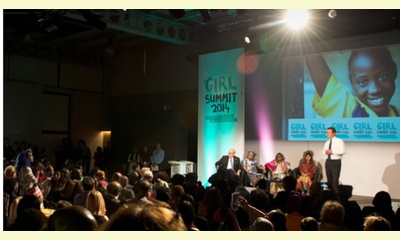|
|
Gender equality takes center stage — but will resources reach the grassroots?
un articulo por Anna Patton, Devex
A month ago, London drew the world’s attention to sexual
violence in conflict, with former United Kingdom Foreign
Secretary William Hague and Hollywood actress Angelina Jolie
leading a huge public campaign to end impunity. 
UK Prime Minister David Cameron speaks during the Girl Summit 2014 in London. Photo by: Paul Shaw / Number 10 Gov / CC BY-NC-ND
click on photo to enlarge
Another high-profile event — the Girl Summit — held in the
city last Tuesday [July 22], pushed for an end to female genital
mutilation and child marriage within a generation. This
unprecedented attention to women’s and girls’ rights — with
ministers, ambassadors and first ladies attending last week —
was widely welcomed by NGOs.
Sarah Cornish, a gender adviser for Save the Children who has
been working on women’s rights and gender-based violence
for the past 15 years, told Devex advocates in this area were
“lone voices” until relatively recently, and described the
summit as “groundbreaking stuff.”
Driven in part by Secretary for State for International
Development Justine Greening, the U.K. has had a bumper
year for women and girls.
In spring, lawmakers approved legislation requiring all
development actions to be gender sensitive. Alongside other
commitments made at the End Sexual Violence in Conflict
Summit in June, London is also funding a 35 million pound
($59.43 million) campaign to end FGM in Africa, while the
Department for International Development announced last
week additional funds of 25 million pounds over five years to
help end child, early and forced marriage in 12 countries in
Africa, Asia and the Middle East.
But with new data revealing the extent of both longstanding
practices, representatives from organizations based in the
“global south” questioned whether promised resources would
actually trickle down to those working directly with
communities at risk.
Estimates from UNICEF indicate that 700 million women alive
today were married as children, while over 130 million girls
and women in the 29 most at-risk countries have undergone
some form of FGM. Some countries have made remarkable
progress in reducing FGM prevalence; in others, though, it
remains widespread. In Somalia, for example, some 98
percent of women are affected.
“If they want to [end] this within a generation, a lot of
resources will be needed — not only financial but also human
resources,” Peter Ndonwie, co-founder of the Pan-African
Organization for Research and Protection of Violence on
Women and Children in Ghana, told Devex. “The NGOs have
human resources; they are ready to do it — but if they don’t
have the finances to go out and do the advocacy, to meet with
communities, or support the families, how do you expect they
will achieve it?”
Funding concerns are particularly acute for those working in
remote areas. Resources are scarcer the further one gets from
cities and main roads, said Moses Ntenga from the Ugandan
NGO Joy for Children, even though child marriage is more
common in rural areas.
In India meanwhile, declining external funding is also placing
a strain on organizations. And yet, Arvind Ojha, CEO of the
Rajasthan-based NGO Urmul Trust, told Devex: “The quantum
of the problem is huge. We have to scale up the small
initiatives ... We can’t wait for 20 or 30 years.”
(This article is continued in the discussionboard)
|








|
DISCUSSION
No hay pregunta ligada a este article.
* * * * *
Comentario más reciente:
(The following is continued from the main article listed above.)
DfID’s latest idea to support initiatives to end child marriage promises to establish local community-based programs and, according to an official spokesperson, the department is currently “consulting with different groups to find the best way of making sure funding reaches civil society and grassroots organizations.”
Indeed, supporting communities is among the commitments listed in an international charter to which over 235 organizations including 30 national governments have now signed up. Recognizing that “legislation alone is not enough,” the charter also commits signatories to investing in services and gathering better data.
“[Gender equality] is not just my job, it should be everyone’s job,” said Cornish. “We need every health provider on the frontline to be screening for FGM and CEFM. We need the people providing regular services — health, education, all the big pillars — addressing this like it’s their ethical mandate ... We need it to be completely embedded throughout everything we do — otherwise we reach a fraction of the girls that need us because we’re not working through the big institutions and the big programs.”
And for Colin Walker, campaigns manager at Plan UK, FGM and child marriage cannot be addressed as isolated issues; rather, they are just two of the many manifestations of discrimination against girls.
“When boys reach adolescence, the world opens up, opportunities open up. For girls, the opposite happens,” he told Devex. “When a girl reaches puberty, she starts being seen primarily through her reproductive and sexual [roles] ... [She may be] pulled out of school, forced to marry early, forced into household chores. . ... continuación.

|
|









